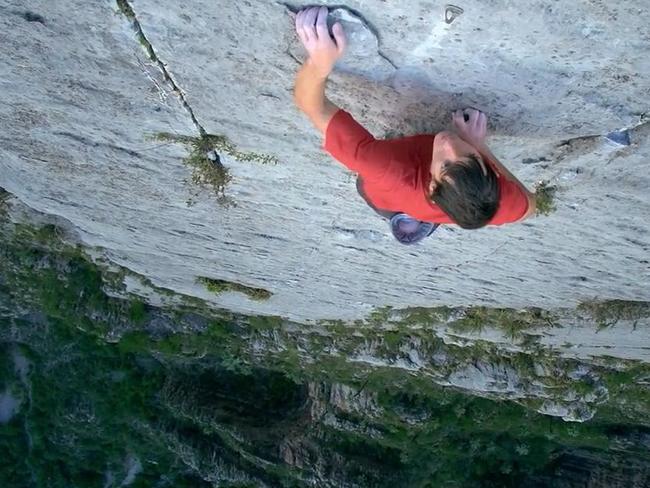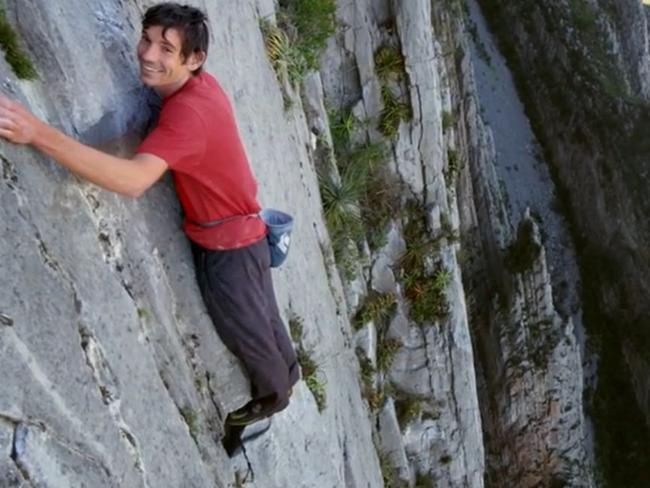Science shows Alex Honnold feels no fear
YOU may know Alex Honnold, whose death-defying feat stunned the world. But you don’t know his brain is unlike anything scientists have ever seen.
YOU may have already heard about Alex Honnold, who climbed the mighty El Capitan in Yosemite National Park without any safety gear on the weekend.
The elite rock climber reached the summit in about four hours using only his hands and feet. The 31-year-old became the first person to climb the 3000-foot (914-metre) granite wall alone without a safety harness or ropes to catch him if he fell.
If you do already know his story, you may also be wondering how the hell he had the courage to attempt such a feat in the first place. Is he crazy or stupid? Or both?
Well, science has the answer.
Neuroscientists recently studied Honnold’s brain. They put him in a large machine and then quickly showed him a series of terrifying and off-putting images — toilets overflowing with faeces, mangled and bloody faces, a climber dangling over the void — the sort of stuff that would send most people shivering, gagging, or both.
It didn’t register with Honnold. They hadn’t seen anything like it. His amygdala, the part of the brain that reacts to fear, lay dormant.
“Maybe his amygdala is not firing — he’s having no internal reactions to these stimuli,” said neuroscientist Dr. Jane Joseph. “But it could be the case that he has such a well-honed regulatory system that he can say, ‘OK, I’m feeling all this stuff, my amygdala is going off,’ but his frontal cortex is just so powerful that it can calm him down.”
Medically, it would seem, Honnold does not experience fear. At least not in the way that you or I would. Or, if he does experience it, he requires a lot more to set it off than anyone this team of neuroscientists at least has ever studied.
What Honnold does have in spades, from a neurological perspective, is a tendency to seek out sensations, a drive nearly double that of your average brain based on their study. This pushes him, of course, but it also hints at something darker, something addictive.

This might be the greatest athletic achievement ever. Honnold is from another planet. https://t.co/VyqBIqTueJ
— Chris Sacca (@sacca) June 4, 2017
“I was pretty much elated,” Honnold told The Associated Press about his feat. “I was probably the happiest I’ve ever been. It’s something that I thought about for so long and dreamt about and worked so hard for. I mean, it’s pretty satisfying.”
Honnold, who grew up in Northern California, began preparing for his historic climb two years ago. He scaled the route countless times, rehearsing it while climbing with protective gear and memorising each hole he had to grab and the way he had to position his body until he felt comfortable enough to attempt the “free solo” climb.
The most difficult part of the route is about 2300 feet (700m) off the ground, where there are very small holds where only a thumb can fit.
But even more challenging was overcoming the mental hurdle. “Each year I would show up and it would seem just much too daunting,” said Honnold, who has been climbing for 20 years. “To walk up to the base of the climb without rope and hardness, it just feels a little outrageous. Getting over that side of it, was the hardest part.”
Observers said his climb has pushed the limits in a sport that requires a high level of athleticism, risk-taking and mental focus.
“This has never been done before ... and it’s hard to imagine anybody ever coming close to what he’s done,” said Daniel Duane, author of El Capitan: Historic Feats and Radical Routes. “He is totally alone at the top of his game,” he added.

Honnold grew up in the suburbs of Sacramento where he began practising indoor rock climbing at age 11. He dropped out of the University of California Berkeley to conquer Yosemite and other major summits around the world.
Honnold, who spoke calmly as he recounted his achievement, brushed off criticism by those who say he’s being reckless by not wearing protective gear. “I could see how for a non-climber it might seem completely insane. But I’ve devoted 20 years to climbing and probably six or seven to this particular project so, it’s not like I’m just some crazy kid who in the spur of the moment decided to do this crazy thing. It took years of effort,” he said.
The climb up El Capitan used to take days to complete with the aid of ropes, safety gear and a partner. In the past few decades, speed climbers working in tandem and using ropes have set records in reaching the top of the steep cliff.
In January 2015, Tommy Caldwell and Kevin Jorgeson became the first to “free climb” the Dawn Wall — a particularly steep route to the top of El Capitan — by grabbing just the rock and using ropes only to catch them if they fell. They did it in 19 days.
Honnold is first to climb the iconic rock alone without protection in mere hours.
“To climb without ropes where the slightest slip is literally fatal in that arena requires enormous self-control and focus,” Duane said. “It requires this intense cognitive effort to keep fear at bay and focus on the task in front of you.” He said Honnold has a rare ability to control fear and his body for a long period of time.
“He’s shown awesome grace under pressure,” said Hans Florine, a fellow climber who with Honnold holds the speed record for climbing the Nose route of El Capitan in about two hours and 23 minutes.
The historic ascent will be featured in a National Geographic documentary.

— with Nate Scott, Fox Sports (US) and AP



